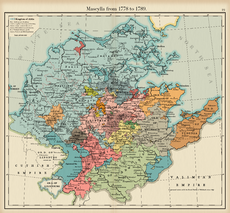Mascyllary Revolution of 1847: Difference between revisions
mNo edit summary |
mNo edit summary |
||
| Line 21: | Line 21: | ||
'''Supported by:'''<br>{{flagicon image|Flag of Cuthland.png}} [[Second Cuthish Empire]]<br>{{flagicon image|Valimia-1700-1850.png}} [[Valimian Empire]] | '''Supported by:'''<br>{{flagicon image|Flag of Cuthland.png}} [[Second Cuthish Empire]]<br>{{flagicon image|Valimia-1700-1850.png}} [[Valimian Empire]] | ||
| combatant2 = {{flagicon image|MascyllaFlagIII.png}} Insurrectionists<br>{{flagicon image|Mascyllary_Kingdom_coat_of_arms.png}} [[Reichswehr (Mascylla)|Mascyllary ''Reichswehr'']] <small>(defected)</small> | | combatant2 = {{flagicon image|MascyllaFlagIII.png}} Insurrectionists<br>{{flagicon image|Mascyllary_Kingdom_coat_of_arms.png}} [[Reichswehr (Mascylla)|Mascyllary ''Reichswehr'']] <small>(defected)</small> | ||
| commander1 = {{flagicon image|FlagAldia.png}} {{flagicon image|Standard_of_the_Mascyllary_Kingdom_(1793).png}} [[Monarchy of Mascylla|Lucas II]]<br>{{flagicon image|FlagAldia.png}} {{flagicon image|Standard_of_the_Mascyllary_Kingdom_(1793).png}} Christoph | | commander1 = {{flagicon image|FlagAldia.png}} {{flagicon image|Standard_of_the_Mascyllary_Kingdom_(1793).png}} [[Monarchy of Mascylla|Lucas II]]<br>{{flagicon image|FlagAldia.png}} {{flagicon image|Standard_of_the_Mascyllary_Kingdom_(1793).png}} Christoph Herzog von und zu Neitzel<br>{{flagicon image|FlagAldia.png}} {{flagicon image|Standard_of_the_Mascyllary_Kingdom_(1793).png}} Wilhelm Graf von Lüderich<br>{{flagicon image|Standard_of_the_Mascyllary_Kingdom_(1793).png}} [[Prime Minister of Mascylla#List of Prime Ministers (1793–present)|Friedrich Anton Graf von Gäste]]<br>{{flagicon image|FlagAdwhin.png}} [[Kingdom of Adwinia|Theodore Albert VII]]<br>{{flagicon image|Flag_of_Bavaria_(striped).svg}} [[Kingdom of Holnia|Charles Maximilian IV]]<br>{{flagicon image|Flag_of_North_Rhine-Westphalia.svg}} {{flagicon image|Valimia-1700-1850.png}} [[List of Valimian monarchs|Anthony II]] | ||
| commander2 = {{flagicon image|MascyllaFlagIII.png}} [[Monarchy of Mascylla|Sophia Alexandra]]<br>{{flagicon image|MascyllaFlagIII.png}} [[Prime Minister of Mascylla#List of Prime Ministers (1793–present)|Emmanuel Heinrich Lyder]]<br>{{flagicon image|MascyllaFlagIII.png}} Anton Graf von Roisner | | commander2 = {{flagicon image|MascyllaFlagIII.png}} [[Monarchy of Mascylla|Sophia Alexandra]]<br>{{flagicon image|MascyllaFlagIII.png}} [[Prime Minister of Mascylla#List of Prime Ministers (1793–present)|Emmanuel Heinrich Lyder]]<br>{{flagicon image|MascyllaFlagIII.png}} Anton Graf von Roisner | ||
| strength1 = ~90,000 men, 10,000 Cuthish auxilliary troops | | strength1 = ~90,000 men, 10,000 Cuthish auxilliary troops | ||
Revision as of 20:27, 17 January 2023
This article is incomplete because it is pending further input from participants, or it is a work-in-progress by one author. Please comment on this article's talk page to share your input, comments and questions. Note: To contribute to this article, you may need to seek help from the author(s) of this page. |
| Mascyllary Revolution of 1847 | |||||||
|---|---|---|---|---|---|---|---|
 Cheering revolutionary troops proclaim the revolution in Königsreh, on 28 October 1847 | |||||||
| |||||||
| Belligerents | |||||||
|
| ||||||
| Commanders and leaders | |||||||
|
|
| ||||||
| Strength | |||||||
| ~90,000 men, 10,000 Cuthish auxilliary troops | Unknown, up to 180,000 men | ||||||
| Casualties and losses | |||||||
| 900 dead, 2,470 wounded | ~2,000 dead, ~5,000 wounded | ||||||
The Mascyllary Revolution of 1847 (Hesurian: Maskillische Revolution von 1847), also known as the October Revolution (Oktoberrevolution [ˈɔkto:bɐʁe:vo:lʊt͡sjo:n]) was a short period of civil and political unrest in the Mascyllary Kingdom that ultimately culminated in the effects of the 28 October coup d'état: the forced abdication of Lucas II and the proclamation of the Second Mascyllary Kingdom with the election of Sophia I as queen and inauguration of Emmanuel Lyder's populist and libertarian national government in early December.
Following the desastrous outcome of the Second Cutho-Mascyllary War and the Alhstead Wars in their entirety (1832–41), the current political establishment and the monarchy under Lucas II in particular earned growing criticism and unfavorable review for the rising influence of the middle and lower class, anticipating the emergence of republicanism through unavoidable class conflict. The discomfort of the fiercely nationalistic populous, paired with a government that grew more authoritarian with the March Laws of 1847 (which arbitrarily and unconstitutionally revoked trading rights), led to the rise of an insurrectionist movement originating in Königsreh, later known as the Cornflower Uprising of 1847 (Blaublumenaufstand von 1847). The bloody revolt, though ultimately unsuccessful at last, prompted other riots, especially within the country's military, to rise up and seek the overthrow of Lucas II.
The 28 October coup d'état, largely supported by the peasantry and rogue military factions, deposed Lucas II as King, and despite fierce resistance by the government and elements of the coup originally seeking to overthrow the monarchy entirely, elected Sophia as Queen. She suspended the government under Friedrich Anton Graf von Gäste, and later confirmed a cabinet of Emmanuel Heinrich Lyder. In 1848, Mascylla officially became a constitutional monarchy and Sophia rejected the style of Empress (Kaiserin) as had been offered by the Flussmund National Convention.
The revolution primarily introduced further protections and rights for the socialist peasantry, such as the constitutional right to work (Recht zur Arbeit), and bolstered support in the current administration after the coup. While lofty ambitions by the radical working class and romanticist liberal middle-class were ultimately not met, living conditions for peasants (who comprised 85% of the total population in 1850) improved drastically with the final abolition of serfdom and forced labor.
While intervention from other Berean powers were limited, safe for the direct involvement of the Valimian Empire, the Second Cuthish Empire tried to support Lucas II's monarchy with 10,000 auxilliary forces in order to safeguard its territorial gains and political influence. The national government formed by the revolution had a particularly strong anti-Cuthish sentiment and thus assumed to steer a more active Berean foreign policy, ultimately contributing to the antagonism between the Cuthish and Mascyllary nations as a whole and the derivation of the later Great War.
Background and Mascylla before the uprising
Revolutionary events
Königsreh uprising
28 October coup d'état
Following fights
Aldia
Adwinia
Holnia
Welsbach
Phalia
Pereuth
Flussmund National Convention
Aftermath
Part of a series on the |
|---|
| History of Mascylla |
 |
|
|
